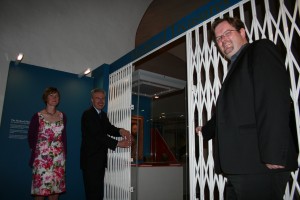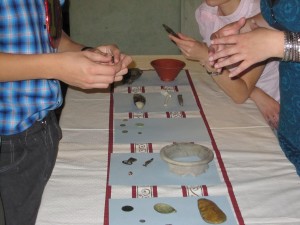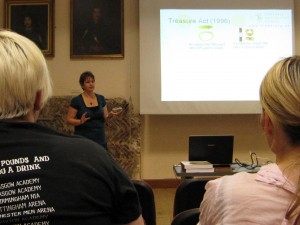Total posts:
187
07/28/2010
07/27/2010
Fortuitous timing – my blog starts during this year’s cavalcade of events that make up the Festival of British Archaeology 2010. It’s the fortnight that I trot off round the county (and slightly beyond*) so that people can show me the finds they have made without having to stray too far from home.
My week began at Rockbourne Roman Villa where I saw all sorts of pottery and flint finds, mostly discovered by youngsters – budding archaeologists of the future? I have since been to Andover Museum, Southampton, Christchurch (technically now in Dorset*), finally ending up in Portsmouth where a celebratory ice cream was enjoyed. For full details of all our events are available in the events calendar
I have taken some finds in for recording onto the database which is exciting. If you have missed me then feel free to get in touch to arrange an appointment to see me in Winchester. You could also drop objects off at your local museum which, if recordable, will be forwarded to me. To make sure, request that they are marked for my attention.
I look forward to meeting you, if not during the next Festival then at your convenience in Winchester. Enjoy what remains of the 2010 Festival of British Archaeology!
07/26/2010
Photos of the event which took place at Frome Library on 22nd July can be found on the library’s Flicker account:
http://www.flickr.com/photos/somersetlibraries/page1/
Everyone involved in the event would also like to thank the library staff for their support and help on the day as they rearranged the library to accommodate us!!!
07/26/2010
Its been a busy week in Colchester celebrating our heritage as part of the Festival of British Archaeology
The festival kicked off in Colchester with the opening of our Medieval Treasures exhibition in Colchester Castle. Helen Geake (one of the Schemes Finds Advisors and regular on Time Team) came along to open the exhibition which contains artefacts and documents relating to civic pride, regal image and religious art.

The exhibition contains a cross loaned from the the Royal Collections, a late medieval enamelled gold cross which is still worn by the Abbot of Buckfast Abbey (Devon) each Christmas and several objects found by metal detectorists throughout the county including a gold finger ring (PAS record @ ESS-A3CCF3 ) and a copper alloy devotional badge depicting the crucifixion ( ESS-302D31).
The first weekend of the Festival saw our local Young Archaeologists (YAC) conducting a survey of the ruins immediately outside the front of Colchester Castle. As well as forming part of the defences of the Castle, there is also the remains of a Medieval Chapel, with origins going back to an Anglo-Saxon wooden chapel with painted wall plaster (part of which can be seen in the Anglo-Norman gallery of the Castle Museum). The YAC members learnt how to draw scale plans and looked at Roman material recycled by the Normans for their building projects.
Across town from the Castle, there was a Medieval Fun Day at St Botolphs Priory, complete with medieval reenactors, music and crafts. There was even a chance to discover more about the beasties and bugs of the natural world, such as a stag beetle (called a Thunder Beetle) was believed to summon thunder and lightning storms!!

And if all that didn’t provide enough of a chance to find out more about archaeology and history in the area, there were opportunities to handle objects from the museums collection at two events in the Castle. Working with artefacts everyday and meeting metal detectorists can almost make you forget just how privileged we are to hold objects from the past, giving us a direct connection to people who lived in your area before you. These handling sessions were great for children and members of the public who are used to seeing history through textbooks and TV, and artefacts through glass cases in the museum. The reaction of both adults and children, when they realised they were holding a palaeolithic flint axe (one of the oldest human artefacts people are ever likely to see!) was just fantastic and really helped to bring history and archaeology to life.

The festival continues until the end of the week, and there are still more oppertunities to get involved. On both Thusrday (29th) and Friday (30th) between 10am and midday come along to the Castle Museum to hold some history – from stone axes, medieval horse decorations down to Victorian clay pipes! And if you want to hear me talk instead of typing, why not come along Friday to the Castle’s afternoon talk “The Public Contribution to Anglo-Saxon Archaeology” where you can find out how metal detected finds are helping to change our interpretations of the past.

07/26/2010
On the 26th July 2010, the Scheme recorded the 400,000 record on the database; another Roman coins, this time
a nummus of the House of Constantine. We had an internal challenge, with the Deputy Head down to buy the
person who recorded this object, a bottle of sparkling wine. The landmark object is show below and was
recorded by Tom Brindle, our acting FLO for Staffordshire
and the West Midlands.
 PAS record number: WMID-D6D183
PAS record number: WMID-D6D183
Object type: Coin
Broadperiod: Roman
County of discovery: Shropshire
Stable url: https://finds.org.uk/database/artefacts/record/id/400298
Several FLOs expressed dismay, that the object was a Roman coin and a metal detector find, I think they were
hoping for a lithic or something else found by a fieldwalker for a change… However, coins and metal
detectorists are the best represented on our database….
| Records |
Finds recorded |
Year of recording |
| 3476 |
4588 |
1998 |
| 6128 |
8201 |
1999 |
| 11323 |
18106 |
2000 |
| 11481 |
16368 |
2001 |
| 8164 |
11996 |
2002 |
| 14657 |
21684 |
2003 |
| 26383 |
39000 |
2004 |
| 33919 |
52202 |
2005 |
| 37502 |
58311 |
2006 |
| 49308 |
79052 |
2007 |
| 37455 |
56449 |
2008 |
| 39981 |
66481 |
2009 |
| 112893 |
190091 |
2010 |
You might wonder why these figures don’t always match the Annual Reports; well, the database is constantly
being worked on, errors corrected, finds removed if duplicate records and so on. There’s some blips in
the figures being recorded – 2002 for example being foot and mouth hit, in 2003 the Scheme went National and
we phased in our new database and in March 2010 we imported 2 large datasets from IARCW and CCI (and you
might have heard about 52,503 coins found in Somerset – only 1 record of those though – April). However the
2010 figures are encouraging when you look at the statistics for recording since we went live with our new
database (shown below with a comparison to 2009, same period).
Statistics for 2009
| Records |
Objects |
Month |
| 3638 |
4395 |
1 |
| 2694 |
5410 |
2 |
| 2842 |
3414 |
3 |
| 3191 |
6284 |
4 |
| 3768 |
5229 |
5 |
| 3307 |
4429 |
6 |
| 3152 |
3819 |
7 |
Statistics for 2010
| Records |
Objects |
Month |
| 4290 |
12274 |
1 |
| 3509 |
5526 |
2 |
| 88596 |
90380 |
3 |
| 4191 |
57775 |
4 |
| 3957 |
5255 |
5 |
| 4490 |
14518 |
6 |
| 3860 |
4363 |
7 |
07/23/2010
I don’t want this blog to only feature the spectacular finds, the ones a quick search of ‘finds of note’ would bring up. So this week I want to talk about a common find that gives an insight into the mind of a queen.
One of my favorite talking points in my handling collection is a James I penny, a coin that illustrates a lot about the politics of the time. Today, inspired by SUSS-1A84C1 I recorded last week, I wanted to draw your attention to the legend on the Mary I coins issued in the 10 months (1553-4) she reigned alone before her marriage: ‘VERITAS TEMPORIS FILIA’; ‘Truth is the daughter of time’. Here is a less worn version:

Mary I has a controversial reputation, not least down here in Lewes. Raised a Roman Catholic and for much of her early childhood her father’s (Henry VIII) official heir she never accepted his ‘divorce’ from her mother, Katherine of Aragon. By declaring the marriage illegal the ‘divorce’ (actually an anullment) made Mary illegitimate and removed her from the line of succession, she had many dark years of virtual imprisonment and relative poverty. Later her father, and parliament, legally acknowledged her place in the succession, after her brother Edward VI, although she was still officially illigitimate, and her living conditions improved. Her reign was controversial for attempts to re-introduce the Catholic faith, including persecution of Protestants.
The legend therefore refers to the vindication of her view that she was the legitimate heir to her father and therefore should be Queen. It also refers to the restoration of the ‘true faith’, Catholicism. Time, by bringing her to the throne, had shown her view to be the ‘true’ one. The pleasing fact that Truth, like many Roman personifications, is a female adds to the aptness of the legend.
The audience of a coin legend and how they are selected is a large discussion and one you’ll be glad to hear I am not going to go into here. This coin however reminds her subjects, powerful and ordinary, other kingdoms and, of course, future readers like us, of the power of providence to bring about the restoration of her ‘true’ claim to the throne and through her the ‘true faith’, despite usurpers and the Protestant and patriarchal forces ranged against her, not least her own father.
 PAS record number: WMID-D6D183
PAS record number: WMID-D6D183




